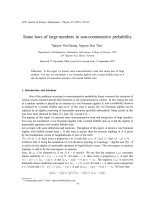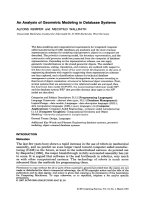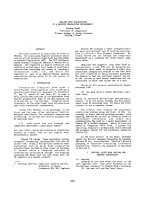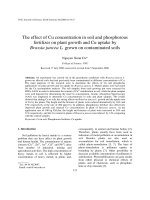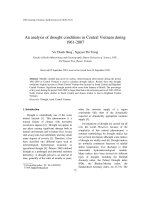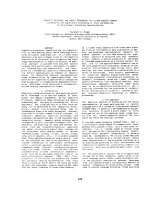Báo cáo " An analysis of drought conditions in Central Vietnam during 1961-2007 " ppt
Bạn đang xem bản rút gọn của tài liệu. Xem và tải ngay bản đầy đủ của tài liệu tại đây (182.61 KB, 7 trang )
VNU Journal of Science, Earth Sciences 26 (2010) 75-81
75
An analysis of drought conditions in Central Vietnam during
1961-2007
Vu Thanh Hang
*
, Nguyen Thi Trang
Faculty of Hydro-Meteorology and Oceanography, Hanoi University of Science, VNU,
334 Nguyen Trai, Hanoi, Vietnam
Received 05 September 2010; received in revised form 24 September 2010
Abstract. Monthly rainfall data given by surface meteorological observations during the period
1961-2007 in Central Vietnam is used to calculate drought indices. Results show that drought
conditions slightly increase in North Central Vietnam but decrease in South Central and Highland
Central Vietnam. Significant drought periods often occur from January to March. The percentage
of dry years during the period 1961-2007 is larger than that in the reference period of 1961-1990 in
North Central while smaller in South Central and almost similar to that in Highland Central
Vietnam.
Keywords: Drought, trend, Central Vietnam.
1. Introduction
∗
Drought is undoubtedly one of the worst
natural hazards [1]. This phenomenon is a
normal feature of climate with inevitable
occurrence appears [2]. Drought can appear in
any place causing significant damage both in
natural environment and in human lives. It may
start at any time, last indefinitely and may attain
many degrees of severity [3]. Therefore, it has
been classified into different types such as
meteorological, hydrological, economic, or
agricultural drought [4]. Palmer (1965) defined
drought as a prolonged and abnormal moisture
deficiency. A drought period is an interval of
time, generally of the order of months or years,
_______
∗
Corresponding author. Tel.: 84-4-38584943.
E-mail:
when the moisture supply of a region
consistently falls short of the climatically
expected or climatically appropriate moisture
supply [5].
Investigations of drought are carried out all
over the world. However, because of the
complexity of this natural phenomenon, a
common methodology for drought studies has
not yet been developed, althought some indices
of drought are widely used [6]. Drought indices
are normally continuous functions of rainfall
and/or temperature, river discharge or other
measurable hydrometeorological variable.
Many indices have been devised for different
types of drought, including the Rainfall
Anomaly index, the Palmer Drought index
(PDI), the Bhalme-Mooley index, the
Standardized Anomaly index, etc [5,7-9]. The
V.T. Hang, N.T. Trang / VNU Journal of Science, Earth Sciences 26 (2010) 75-81
76
most well known and the widely used of the
drought index is PDI. The index has been used
in various studies to illustrate the areal extent
and severity of drought in the northeastern
United States during the early to mid-1960s and
across the United States during the hot, dry
summer of 1980 [10,11].
An analysis of moisture extremes over
Europe shows strong decadal-scale variability
in drought frequency with the 1940s and early
1950s experiencing widespread and severe
droughts, which was repeated with the same
pattern in 1989 and 1990 [12]. The summer of
1992 was extremely hot and dry in central and
eastern Europe, as was the summer of 1995
throughout much of western Europe [13].
In this paper the frequency and intensity of
the drought periods in Central Vietnam is
investigated during the period 1961-2007.
2. Data and methodology
2.1. Data
Monthly rainfall data gathered from 25
surface meteorological stations in Central
Vietnam is used. These stations are located in
three climatic sub-regions including the North
Central sub-region (10 stations), South Central
sub-region (8 stations) and Highland Central
sub-region (7 stations).
2.2. Methodology
Rainfall distribution is one of the basic
indentifiers of drought occurrence in a given
region. The index of anomaly P is calculated as
[6]:
∑
=
=
n
i
i
ij
j
x
x
n
P
1
1
(1)
where the symbol j = 1, , N denotes years, x
i
is
the total annual precipitation in the i
th
station,
i
x
is the averaged annual precipitation for the station
i
th
, and n is number of stations. Values of P > 1
indicate wet conditions, values of P < 1 indicate
drought conditions, and P = 1 is normal
condition.
The frequency distribution of annual
precipitation is calculated in the range [3]:
p
PP σ2−<
- extreme dry
pp
PPP σσ −<<−2
- dry (2)
pp
PPP σσ +<<−
- normal
p
PP σ+>
- wet
where P is precipitation in a particular year,
P
is the average precipitation during the period
1961-1990, and
σ
is the standard deviation.
Statistical methods is used to analyse the
long-term variations in precipitation. The long-
term data series are smoothed by using moving
averages and the linear trends are added.
3. Results and discussion
The long-term variations of annual
precipitation anomaly index in the three sub-
regions in Central Vietnam are shown in Figure
1 where 5-years moving average and the linear
trends are given. The linear trends are negative
for North Central and positive for South Central
and Highland Central Vietnam. This implies
that drought conditions increase in North
Central but decrease in South Central and
Highland Central Vietnam. However, it should
be noted that the rate of changes is very small.
The driest years in North Central Vietnam
during the period are 1969, 1977, and 1988
with P index in the range of 0.7 and 0.8. In
V.T. Hang, N.T. Trang / VNU Journal of Science, Earth Sciences 26 (2010) 75-81
77
South Central Vietnam, the low values of P
appear in 1982 and 2004. Other considerable
dry years are 1961, 1967, 1968, 1977, and
1989. The driest years in Highland Central
Vietnam are 1963 and 1977. It is important to
note that there are some differences in the
classification of dry years between the three
sub-regions. The only dry year in the whole
Central Vietnam is the year 1977.
Figure 1. Long-term variations of the area-averaged precipitation anomaly index (colunms) for North Central (a),
South Central (b) and Highland Central (c) Vietnam during 1961-2007. 5-years moving average (curves) is used
and the linear trends are given (lines).
Table 1. Coefficient a
1
in regression equations for five sub-periods over the three sub-regions
Sub-regions
Sub-periods
North
Central
South
Central
Highland
Central
1961-1970 -0.0232 -0.0035 -0.0085
1971-1980 -0.0022 0.0143 0.0042
1981-1990 -0.0048 -0.0213 0.0012
1991-2000 0.0064 0.0579 0.0285
2001-2007 0.0122 0.0176 0.0143
V.T. Hang, N.T. Trang / VNU Journal of Science, Earth Sciences 26 (2010) 75-81
78
Values of coefficient a
1
in the regression
equations of what for five sub-periods over the
three sub-regions are given in Table 1. The sign
of this coefficient indicates the increasing trend
(positive) or decreasing trend (negative) of the
precipitation anomaly index. It is seen that
drought conditions increase during the three
first sub-periods in North Central Vietnam in
which the first period 1961-1970 has the largest
rate of change. The increasing trends of dry
conditions also happen in 1961-1970 and 1981-
1990 in South Central and during the first sub-
period in Highland Central Vietnam. The
decreasing trends of dry conditions occur in the
whole Central Vietnam during the two last sub-
periods where the most significant change is in
1991-2000 in South Central Vietnam.
Monthly variations of the precipitation
anomaly index for three sub-regions are shown
in Figure 2. Dry conditions often occur from
December to July in North Central, from
January to August in South Central and from
November to April in Highland Central
Vietnam. Significant droughts mainly happen
from January to March in the whole Central
Vietnam. The difference in drought occurrence
between the three sub-regions is due to the local
characteristics of rainy season.
Figure 2. Monthly variations of the area-averaged precipitation anomaly index for North Central (a),
South Central (b) and Highland Central (c) Vietnam.
V.T. Hang, N.T. Trang / VNU Journal of Science, Earth Sciences 26 (2010) 75-81
79
In Figure 3 the percentage distribution of
the years in seperate sub-periods according to
the drought criteria (2) is given. The five sub-
periods are 1961-1970, 1971-1980, 1981-1990,
1991-2000 and 2001-2007. The distribution of
these sub-periods is compared to that of the
reference period 1961-1990. The extreme dry
condition only occurs in North Central and
Highland Central Vietnam with low frequency
and have little changes between the sub-
periods. The largest percentage of extreme dry
years is nearly 8% in Highland Central Vietnam
during the first sub-period 1961-1970. In
general, the variation in the percentage of dry
years between the sub-periods is the largest in
South Central and the smallest in Highland
Central Vietnam. It is clearly found that the
percentage of wet years more increases in the
two last sub-periods than in the reference period
in South Central and Highland Central
Vietnam. The averaged percentage of dry years
during 1961-2007 is 17.64% compared to
15.7% in the reference period in North Central,
9.56% compared to 12.5% in South Central and
13.3% compared to 13.2% in Highland Central
Vietnam.
Figure 3. Distribution (in %) of extreme dry, dry, normal and wet years in North Central (a), South Central (b)
and Highland Central (c) Vietnam for five periods and the reference period 1961-1990.
V.T. Hang, N.T. Trang / VNU Journal of Science, Earth Sciences 26 (2010) 75-81
80
Figure 4. The linear trends of the percentage of extreme dry and dry years for North Central (a),
South Central (b) and Highland Central (c) Vietnam for five sub-periods.
The percentage of extreme dry and dry
years over the sub-regions for the sub-periods is
clearly shown in Figure 4. It can be seen that
dry conditions slightly increase in North
Central while decrease in South Central and
Highland Central in which the rate of change in
Highland Central Vietnam is the largest. The
maximum percentage of dry years occurs in the
sub-period 1991-2000 in North Central and the
minimum value is in South Central Vietnam in
the same sub-period.
4. Conclusion
The results of this study show that drought
conditions slightly increase in North Central
while decrease in South Central and Highland
Central Vietnam during 1961-2007. The
increasing trend of drought conditions happens
in the first period 1961-1970 in the whole
Central Vietnam in which the rate of change in
North Central Vietnam is the largest. The
decreasing trend of drought conditions occurs
in the whole Central Vietnam during the two
last sub-periods where the most significant
change is in 1991-2000 in South Central
Vietnam. The averaged percentage of dry years
during 1961-2007 is larger than that in the
reference period 1961-1990 in North Central
while smaller in South Central and almost
similar to that in Highland Central Vietnam.
Acknowledgements
Funding for this research was provided by
QG-10-12 project.
V.T. Hang, N.T. Trang / VNU Journal of Science, Earth Sciences 26 (2010) 75-81
81
References
[1] D.A. Wilhite, Drought as a natural hazard:
concepts and definitions. Drought: a global
assessment, London: Routledge Publishers,
2000.
[2] A.K. Mishra, V.R. Desai, Drought forecasting
using stochastic models, Stoch. Environ. Res.
Risk Assess 19 (2005) 326.
[3] World Meteorological Organization (WMO),
Drought and agriculture, WMO/TN 138,
Geneva: WMO, 1975.
[4] V. Yevjevich, L. da Cunha, E. Vlachos, Eds.,
Coping with droughts, Water Resources, 417 pp,
1983.
[5] W.C. Palmer, Meteorological drought, Research
Paper 45, U.S. Department of Commerce,
Weather Bureau, Washington D.C., 58pp,1965.
[6] E. Koleva, V. Alexandrov, Drought in the
Bulgarian low regions during the 20
th
century,
Theor. Appl. Climatol. 92 (2008) 113.
[7] M.P. Van Rooy, A rainfall anomaly index
independent of time and space, Notos 14 (1965)
43.
[8] H.N. Bhalme, D.A. Mooley, Large scale
droughts/floods and monsoon circulation, Mon.
Wea. Rev. 108 (1980) 1197.
[9] R.W. Katz, M.H. Glantz, Anatomy of a rainfall
index, Mon. Wea. Rev. 114 (1986) 764.
[10] W.C. Palmer, “The abnormally dry weather of
1961-1966 in the northeastern United State” in
the Proc. Conf. Drought in North-eastern United
State, Jerome Spar, Ed., New York University
Geophys. Res. Lab. Rep. TR-68-3, 1967, p. 32.
[11] T.R. Karl, R.G. Quayle, The 1980 summer heat
wave and drought in historical perspective, Mon.
Wea. Rev. 109 (1981) 2055.
[12] K.R. Briffa, P.D. Jones, M. Hulme, Summer
moisture availability across Europe, 1892-1991:
an analysis based on the Palmer Drought
Severity Index, Int. J. Climatol. 14 (1994) 475.
[13] J.P. Palutikof, S. Subak, M.D. Agnew, Economic
impacts of the hot summer and unusually warm
year of 1995, Norwich, University of East
Anglia, 1997.

